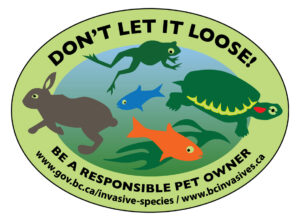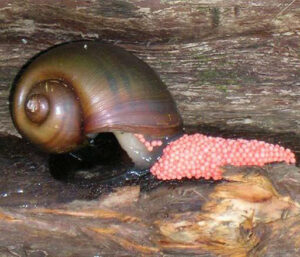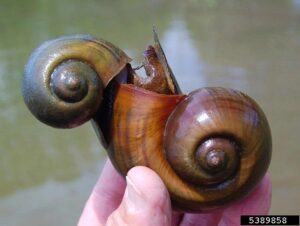There are a number of invasive snails that are found in North America and threaten native, freshwater ecosystems. Apple snails (particularly the Channeled apple snail, Pomacea canaliculata) are considered a high risk invasive species for B.C. and the goal is to continue preventing any introductions or establishment of these snail species in B.C. In North America, the Channeled apple snail is current found in southeastern and southwestern U.S.A. and Hawaii.
Apple snails are some of the largest freshwater snail species in the world: there are records of snails measuring up to 15 cm but they are more commonly 5-10 cm. Their shells have 5-6 whorls with deep grooves (or channels, as their name suggests). They are also well known for their bright pink egg clusters (200-600 eggs), which are usually found attach to tree stumps, logs or rocks just above the waterline of lakes and ponds. Apple snails can withstand a variety of environmental conditions and are typically found in areas with slow-moving water, like ponds, rivers, ditches, wetlands and agricultural areas.
- Channeled apple snail
- Island apple snail
Apple snails are common in aquarium trade and their introduction to North America is likely due to irresponsible releases into the wild. When released into new environments, apple snails are capable of reaching very high densities (like many other invasive snails), which makes them a biofouling pest in water intake pipes, for example. These dense populations can wreak havoc on aquatic plant life and they are also able to cause food web shifts in local wetlands ecosystems. Their invasive populations have not only caused issues with native snail species, but also with rice and taro crops, in southern U.S.A. It is also important to know that they can transmit “rat lungworm”, which causes a fatal form of meningitis, to humans (and other mammals) if they are eaten raw.
What Can We Do?
CLEAN DRAIN DRY: Clean off all plant parts, animals and mud from watercraft and equipment (e.g. boat trailers, paddles, fishing gear, waders and boots). Drain onto land all compartments and accessories that can hold water (e.g. bilge, ballast, live wells, buckets) and remove plugs before traveling. Dry the watercraft and equipment before launching into another body of water.

DON’T LET IT LOOSE: Do not purchase highly invasive species from pet stores. Never release aquarium pets or plants into the wild.
REPORT: Report all sightings of invasive species to CSISS on our website, to the Province with their online form or on the ReportInvasive mobile app.
For more information about invasive snails in Canada, visit here.
Literature and Resources
https://bmcecolevol.biomedcentral.com/articles/10.1186/1471-2148-7-97
https://wildlife.ca.gov/Conservation/Invasives/Species/Channeled-Apple-Snail
http://www.dnr.louisiana.gov/assets/OCM/False_River_Project/2017/May2017/AppleSnailFlyer.pdf
https://www.invasivespeciesinfo.gov/aquatic/invertebrates/channeled-apple-snail

